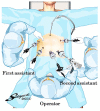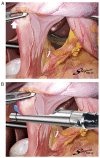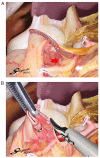Intracorporeal linear‑stapled gastroduodenostomy in totally laparoscopic distal gastrectomy for gastric cancer: Consideration of the intraoperative management of the duodenal wall between the transecting staple line and anastomotic staple line (Review)
- PMID: 37545615
- PMCID: PMC10398627
- DOI: 10.3892/ol.2023.13940
Intracorporeal linear‑stapled gastroduodenostomy in totally laparoscopic distal gastrectomy for gastric cancer: Consideration of the intraoperative management of the duodenal wall between the transecting staple line and anastomotic staple line (Review)
Abstract
The first part of the duodenum consists of the intraperitoneal segment, called the duodenal bulb, and the retroperitoneal segment. Regarding the blood supplying the duodenal bulb, which is the portion utilized in anastomosing the duodenum and remnant stomach following distal gastrectomy, the arterial pedicles branching off from the gastroduodenal artery are reported to reach the posterior wall first and then spread over the anterior wall, where they anastomose. When performing intracorporeal linear-stapled gastroduodenostomy following totally laparoscopic distal gastrectomy, the blood supply of the duodenal wall between the transecting staple line and anastomotic staple line needs to be considered because both transection of the duodenal bulb and the gastroduodenostomy are performed using an endoscopic linear stapler and the duodenal wall between the staple lines can be ischemic after the anastomosis. Since it needs to be decided intraoperatively whether this duodenal site is preserved or removed, the present review discusses the technical differences among several procedures for intracorporeal linear-stapled gastroduodenostomy, classifying them into two groups on the basis of the intraoperative management of this duodenal site. When this site is preserved, the blood supply of the duodenal wall needs to be retained with certainty. On the other hand, when this site is removed, the ischemic portion of the duodenal wall needs to be identified and removed. Furthermore, in both groups, an adequate anastomotic area needs to be secured. In conclusion, surgeons need to be familiar with the anatomical features of the duodenal bulb, including its blood perfusion and shape, when carrying out intracorporeal linear-stapled gastroduodenostomy.
Keywords: B-I reconstruction; TLDG; blood supply; intracorporeal linear-stapled gastroduodenostomy.
Copyright: © Tokuhara et al.
Conflict of interest statement
The authors declare that they have no competing interests.
Figures





References
-
- von Trotha KT, Butz N, Grommes J, Binnebösel M, Charalambakis N, Mühlenbruch G, Schumpelick V, Klinge U, Neumann UP, Prescher A, Krones CJ. Vascular anatomy of the small intestine-a comparative anatomic study on humans and pigs. Int J Colorectal Dis. 2015;30:683–690. doi: 10.1007/s00384-015-2163-4. - DOI - PubMed
Publication types
LinkOut - more resources
Full Text Sources
